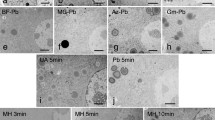Summary
New lanthanide methods for the histochemical detection of non-specific alkaline phosphatase in the light microscope are described and compared with already existing techniques for the light microscopical demonstration of this enzyme. To avoid formation of insoluble lanthanide hydroxide at alkaline pH citrate complexes with the capture ions cerium, lanthanum and didymium were used. A molar ratio of 11 mM citrate/14 mM capture reagent is proposed. For preincubated sections, pretreatment in chloroform-acetone and fixation in glutaraldehyde, for non-preincubated sections fixation in glutaraldehyde yielded the best results. 4-Methylumbelliferyl and 5-Br-4-Cl-3-indoxyl phosphate were found to be the most suitable substrates. For routine purposes 4-nitrophenyl, 1-naphthyl, 2-naphthyl and 2-glycerophosphate were also sufficient; naphthol AS phosphates were inferior but still suitable. After incubation for 5–60 min at 37° C lanthanide phosphate was converted into lead phosphate which was visualized as lead sulfide. At pH 9.2–9.5 enzyme activity was demonstrated at many sites such as intestinal, uterine, placental, renal and epididymal microvillous zones, plasma membranes of arterial, sinus and capillary endothelial cells, vaginal and urethral epithelium, smooth muscle cells, myoepithelial cells as well as excretory duct cells of salivary and lacrimal glands and in secretory granules of laryngeal glands. In comparison with Gomori's calcium, Mayahara's lead, Burstone's and Pearse's azo-coupling, McGadey's tetrazolium salt and Gossrau's azoindoxyl coupling technique the lanthanide methods detected alkaline phosphatase activities at identical or additional sites depending on the respective procedure. However, in contrast to the other methods especially the cerium citrate procedure yielded a more precisely localized and more stable reaction product, can be used with all available alkaline phosphatase substrates including those up till now less suitable or unsuitable for light microscopic alkaline phosphatase histochemistry.
Similar content being viewed by others
References
Geyer G (1973) Ultrahistochemie. 2., überarb. u. erw. Aufl. Gustav Fischer, Jena
Halbhuber KJ, Zimmermann N (1985) Light microscopical localization of enzymes by means of cerium-based methods. II. A new cerium-based technique for alkaline phosphatase. Acta Histochem 77:67–73
Halbhuber KJ, Zimmermann N (1986) Light microscopical localization of acid and alkaline phosphatase activity by lanthanumlead-(LaPb)-methods. Acta Histochem 80:35–40
Halbhuber KJ, Zimmermann N (1987a) Light microscopical localization of enzymes by means of cerium-based methods. V. Optimization of the cerium-lead-(Ce-Pb)-technique for alkaline phosphatase. Acta Histochem 81:71–75
Halbhuber KJ, Zimmermann N (1987b) Gadolinium and didymium (praseodymium, neodymium) cations as capture agents in light microscopical histochemistry of acid and alkaline phosphatase. Acta Histochem 81:223–225
Hulstaert CE, Kalicharan D, Hardonk MJ (1983) Cytochemical demonstration of phosphatases in the rat liver by a cerium-based method in combination with osmium tetroxide and potassium ferrocyanide postfixation. Histochemistry 78:71–79
Lojda Z, Gossrau R, Schiebler TH (1979) Enzyme histochemistry. A laboratory manual. Springer, Berlin Heidelberg New York
Mayahara H, Hirano H, Saito T, Ogawa K (1967) The new lead citrate method for the ultracytochemical demonstration of activity of nonspecific alkaline phosphatase (orthophosphoric monoester phosphohydrolases). Histochemistry 11:88–96
Okada T, Kobayashi T, Hakoi K, Seguchi H (1987) A simple method for light microscopical visualization of phosphohydrolase activities in materials processed for cerium-based ultracytochemistry. Acta Histochem Cytochem 20:105–110
Robinson JM, Karnovsky MJ (1983) Ultrastructural localization of several phosphatases with cerium. J Histochem Cytochem 31:1197–1208
Veenhuis M, Flik G, Wendelaar Bonga SE (1980a) CeCl3: a new capturing agent for the cytochemical demonstration of phosphatase activity. In: Brederoo P, De Priester W (eds) Electron microscopy 1980, vol. 2. Seventh European Congress on Electron Microscopy Foundation, Leiden, pp 284–285
Veenhuis M, Van Dijken JP, Harder WC (1980b) A new method for the cytochemical demonstration of phosphatase activities in yeasts based on the use of cerous ions. FEMS Microbiol Lett 9:285–291
Author information
Authors and Affiliations
Rights and permissions
About this article
Cite this article
Halbhuber, K.J., Gossrau, R., Möller, U. et al. Light-microscopic histochemistry of non-specific alkaline phosphatase using lanthanide-citrate complexes. Histochemistry 90, 67–72 (1988). https://doi.org/10.1007/BF00495709
Received:
Accepted:
Issue Date:
DOI: https://doi.org/10.1007/BF00495709




